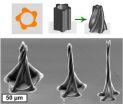(Press-News.org) CHAMPAIGN, Ill. – In the battle of egos, Donald Trump vs. Hugo Chavez might be a draw. But as symbols of power, each resonates differently with different cultures, as cultures nurture different views of what is desirable and meaningful to do with power, according to new research by a University of Illinois marketing expert.
Sharon Shavitt says the relation between culture and one's concepts of power emerge from one's cultural orientation, and how that culture shapes one's beliefs, attitudes and goals.
"People's views of powerful people and what powerful people are supposed to do, as well as what legitimizes power, differs by society and by cultural values," said Shavitt, a professor of business administration.
The study, co-written by Carlos J. Torelli, of the University of Minnesota, examined the role of culture in the meaning and purpose of power by examining the way people perceived, evaluated and responded to power-related stimuli.
The researchers categorized the reactions according to a four-category typology: horizontal versus vertical, and collective versus individual. Their findings highlight the value of advancing existing models of power relations by identifying a key role for cultural variables.
According to the research, the two most contrasting power relations were vertical individualism and horizontal collectivism.
A vertical-individualistic cultural orientation was linked to conceptualizing power as something to be used for advancing one's personal agenda, thereby maintaining and promoting one's powerful status, Shavitt says. By contrast, a horizontal-collectivistic cultural orientation was linked to conceptualizing power as something to be used for benefiting others.
"Cultures predicts distinct power concepts, and those were the two groups that most strikingly contrasted with each other, the self-interested use of power versus benevolence," Shavitt said.
In American culture, for example, it's legitimate for someone who has power to use it for personal, status-oriented gains. Donald Trump, for example, could be seen as a symbol of such culturally nurtured power, because he's "out for himself, and makes no bones about it," Shavitt said.
But in other regions in the U.S., that attitude may not be looked upon quite so charitably. Trump may be popular in Manhattan, but he wouldn't be nearly as popular in, say, North Dakota, Shavitt said.
"We've found that there are distinctions and gradations," she said. "People of different ethnic backgrounds and different cultural orientations – that is, those who espouse different values – respond differently to these ideas of power."
Nor would the Donald be quite so popular in other countries, where the native culture may promote the use of power for the benefit of others – for example, having higher taxes to subsidize health care and higher education – rather than for achieving status and prestige.
"In Latin America, for example, the power paradigm swings away from self-interested zeal for status in favor of more benevolent and less brazenly self-interested ways of conceptualizing power," Shavitt said. "Powerful political leaders such as Hugo Chavez drape themselves in collectivism and are frequently idealized as benefactors whose primary goal is to protect helpless individuals."
While other countries' notion of equality is an equality of outcomes, in the U.S., "our notion of equality is equal opportunity – each one of us each has an equal opportunity to have a good outcome or a bad outcome depending, supposedly, on how hard we work," Shavitt said.
Businesses can use this knowledge of cultural attitudes toward power to their advantage.
"A vertical-individualist orientation predicted liking for brands that symbolize personalized power values of status and prestige, whereas a horizontal-collectivist orientation predicted liking for brands that embody concerns for the welfare of others," she said.
The study included groups commonly used in cross-cultural research (European Americans and East Asians, for example) as well as under-researched groups (Hispanic immigrants, students in Brazil and Norway), thereby increasing the potential coverage of vertical and horizontal cultures and allowing for findings across a broader range of cultures.
Out of the groups surveyed, Brazilians exhibited the highest horizontal-collectivist scores, liking brands that symbolized pro-social values better, while Norwegians scored among the lowest in vertical-individualism orientation, liking brands that symbolized personalized power values less than all the other groups.
Shavitt noted that Scandinavian cultures are much more horizontal and focus more on personal modesty as well as obligations to others.
"If you look at their social policies, they show a strong emphasis on equality of outcomes and provision of help to the least fortunate," she said. "But they're not collectivistic; they're still very individualistic."
In the U.S., with the demographic trend lines pointing to a more multi-cultural society, businesses can adjust their marketing and advertising accordingly by identifying a key role for cultural variables.
"What we're doing is adding another element to the way that marketers can segment their markets – by emphasizing how ethnicity, geography and cultural values come into play in consumers' power motivations," Shavitt said.
INFORMATION:
Portions of the research were part of Torelli's doctoral dissertation, written at Illinois.
Editor's note: To contact Sharon Shavitt, call 217-333-0784; e-mail shavitt@illinois.edu.
Consumer sentiment shaped by differing cultural attitudes toward power
2010-10-20
ELSE PRESS RELEASES FROM THIS DATE:
Bacteria gauge cold with molecular measuring stick
2010-10-20
HOUSTON -- (Oct. 19, 2010) -- Some bacteria react to the cold by subtly changing the chemistry of their outer wall so that it remains pliable as temperatures drop. Scientists identified a key protein in this response mechanism a few years ago, but the question of how bacteria sense cold in the first place remained a mystery. Based on a study by scientists at Rice University and Argentina's National University of Rosario, the answer is: They use a measuring stick.
The study, published in the September issue of Current Biology, involved a series of intricate experiments ...
Osteoporosis drug builds bone in patients with gum disease
2010-10-20
ANN ARBOR, Mich.---A drug marketed to grow bone in osteoporosis patients also works to heal bone wounds in gum disease patients, a University of Michigan study suggests.
"This new approach for the treatment of periodontal disease could allow us to rebuild some of the bone that is lost due to periodontal disease, which until this point has been very difficult to achieve," said Jill Bashutski, clinical assistant professor at the U-M School of Dentistry and first author on the study. "Current treatments to re-grow bone around teeth affected with gum disease have limited ...
A middle class that copes by shopping secondhand
2010-10-20
Conventional wisdom holds that people try to mimic the behavior of the next social class above their own.
Except when it comes to shopping at secondhand stores and yard sales, concludes a new study by Brigham Young University sociology students and faculty.
The study found that high-income shoppers scour the secondhand market for antiques, but everyone else is trying to stretch the family dollar.
"Middle-class shoppers were looking for furniture, some appliances, clothes, things that you could argue are necessities," said BYU sociology professor Ralph Brown. "There's ...
UT professor defines play, discovers even turtles need recess
2010-10-20
Seeing a child or a dog play is not a foreign sight. But what about a turtle or even a wasp?
Apparently, they play, too.
In fact, according to Gordon Burghardt, a psychology professor at the University of Tennessee, Knoxville, many animals -- not just dogs, cats, and monkeys -- need a little play time.
"I studied the behavior of baby and juvenile reptiles for many years and never saw anything that I thought was play. Then I had an epiphany when I saw Pigface, a Nile softshell turtle, batting around a basketball at the National Zoo in Washington, D.C. I realized ...
New clinical trial explores role of vitamin D in preventing esophageal cancer
2010-10-20
CLEVELAND – In a first-of-its-kind clinical trial, physicians at University Hospitals (UH) Case Medical Center who are Case Western Reserve University School of Medicine researchers are exploring the role of Vitamin D in preventing esophageal cancer. Principal Investigator Linda Cummings, MD, along with Amitabh Chak, MD, and Gregory Cooper, MD, from the UH Digestive Health Institute, is recruiting patients with Barrett's esophagus to measure the effects of Vitamin D on protein levels that may influence the risk of developing esophageal cancer.
"Vitamin D is being studied ...
Intricate, curving 3-D nanostructures created using capillary action forces
2010-10-20
ANN ARBOR, Mich.---Twisting spires, concentric rings, and gracefully bending petals are a few of the new three-dimensional shapes that University of Michigan engineers can make from carbon nanotubes using a new manufacturing process.
The process is called "capillary forming," and it takes advantage of capillary action, the phenomenon at work when liquids seem to defy gravity and travel up a drinking straw of their own accord.
The new miniature shapes, which are difficult if not impossible to build using any material, have the potential to harness the exceptional mechanical, ...
Gene activity in the brain depends on genetic background
2010-10-20
SEATTLE, Wash.—October 18, 2010—Researchers at the Allen Institute for Brain Science have found that the same genes have different activity patterns in the brain in individuals with different genetic backgrounds. These findings may help to explain individual differences in the effectiveness and side-effect profiles of therapeutic drugs and thus have implications for personalized medicine. The study is available in this week's online early edition of the Proceedings of the National Academy of Sciences (www.pnas.org).
In this study, the authors compared where in the brain ...
See no shape, touch no shape, hear a shape?
2010-10-20
Scientists at The Montreal Neurological Institute and Hospital – The Neuro, McGill University have discovered that our brains have the ability to determine the shape of an object simply by processing specially-coded sounds, without any visual or tactile input. Not only does this new research tell us about the plasticity of the brain and how it perceives the world around us, it also provides important new possibilities for aiding those who are blind or with impaired vision.
Shape is an inherent property of objects existing in both vision and touch but not sound. Researchers ...
Sniffing out shoe bombs: A new and simple sensor for explosive chemicals
2010-10-20
CHAMPAIGN, Ill. — University of Illinois chemists have developed a simple sensor to detect an explosive used in shoe bombs. It could lead to inexpensive, easy-to-use devices for luggage and passenger screening at airports and elsewhere.
Triacetone triperoxide (TATP) is a high-powered explosive that in recent years has been used in several bombing attempts. TATP is easy to prepare from readily available components and has been difficult to detect. It defies most standard methods of chemical sensing: It doesn't fluoresce, absorb ultraviolet light or readily ionize.
The ...
Old bees' memory fades; mirrors recall of mammals
2010-10-20
A study published Oct. 19 in the open access journal Public Library of Science (PLoS) ONE, shows that not just human memories fade. Scientists from Arizona State University and the Norwegian University of Life Sciences examined how aging impacts the ability of honey bees to find their way home.
While bees are typically impressive navigators, able to wend their way home through complex landscapes after visits to flowers far removed from their nests, the study reveals that aging impairs the bees' ability to extinguish the memory of an unsuitable nest site even after the ...


